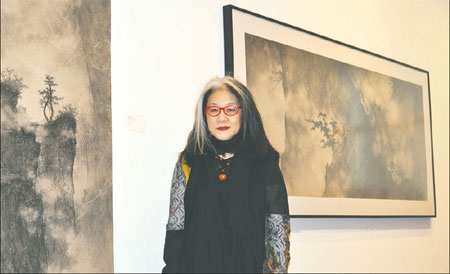Sotheby's moves onto galleries' turf with exhibit
|
Mee-Seen Loong, curator of SHUIMO/Water Ink, says many works exhibited were sold even before the exhibit started. Liu Lian / China Daily |
Sotheby's is hosting its first public exhibition of Asian art with fixed sale prices at its New York headquarters, and more than half the 45 contemporary water-ink paintings by 14 Chinese artists have sold, according to the auction house.
The exhibition, "SHUIMO/Water Ink," opened on March 14 and is on view through March 28. Each painting has a fixed price, from $8,000 to over $1 million. "A lot of them are under $100,000," said Mee-Seen Loong, a consultant to Sotheby's and a former managing director of Sotheby's Hong Kong, who is the exhibit's curator.
The art work with fixed prices rather than being offered in the traditional auction is an attempt by Sotheby's to gain new business at time its auction revenue has declined. It's also a move into an area traditionally run by private art galleries: sales exhibitions. And it's drawing criticism from some gallery owners who deal primarily in Asian art.
"This will be an uphill battle," said Martha Sutherland, principal of M. Sutherland Fine Arts gallery. "We are in the bespoke business and we offer the personal touch."
Beatrice L. Chang, owner of the gallery Dai Ichi Arts, also is hosting a contemporary Chinese water-ink exhibition. "Big auction house is monopolizing this (the art market)," she said. "Galleries are the ones who work hard, who educate people and who are there for collectors for many years to come."
In 2012, Sotheby's reported total revenue of $768.5 million, which included auction and private sales. That was a decline of $63.3 million, or 8 percent, from 2011. The decrease was mainly caused by a $79.4 million, or 11 percent, drop in auction-commission revenue. Private sales were a record $906.5 million, an 11 percent increase from $814.6 million in 2011.
Henry Howard-Sneyd, Sotheby's vice-chairman of, Asian art, said the auction house doesn't see its move into sales exhibitions as a threat to galleries.
"There are new galleries being formed and galleries closing down all the time," he said. "It's a constant cycle. I think Sotheby's is being one of those new faces in that market place. It's just part of the ongoing innovation and creativity of the contemporary art market. "
Howard-Sneyd said the SHUIMO exhibition is "one of those developments where we have found a very sizable niche we can operate in, where we organize exhibitions and sell in a way that a gallery does. And this is something I would expect Sotheby's to do increasingly in the coming years."
"People come for a knowing price, pay the price and leave, whereas there is an uncertainty at the auction that does not suit every buyer," he added.
Many of the SHUIMO paintings were sold before the exhibition opened because Sotheby's sent their images to its long-term clients and established collectors, said Loong. "Some of them simply buy based on the image," she said.
Contemporary Chinese art prices surged to an all-time high in 2012, taking 29 of the top 50 hammer prices in public auctions worldwide, according to Artprice's annual report. The new and rapidly emerging field of contemporary Chinese water-ink painting became hot in 2012, with major Chinese auction houses actively hosting special sessions to introduce artists' works.
Loong, a Chinese art specialist who also produces her own "pop up" art sale exhibitions, said she recognized the rising value of contemporary Chinese water-ink paintings and approached Sotheby's to see if a gallery-type show was possible.
When Sotheby's gave her the go-ahead in February 2012, Loong said she wrote artists she knows and told them she needed their work by the end of that year. "Some of them started painting right away, and some took a long time," she said.
Loong said she was able acquire all 45 paintings directly from the artists because she has known them for a long time and has represented many of them.
"I have done shows for them before," she said. " I've worked with some for years, helping place them in museums and in galleries. I am one of their representatives, in other words. I call myself their big sister."
Sutherland said she didn't think it helps the artists to paint only for a sale at Sotheby's or Christie's. "Hopefully, it gets people interested in Chinese water-ink paintings, and they will come to me to see paintings at a much lower price point, but the quality is much higher," she said.
To Chang, the move into gallery-like showings by the auction houses makes the future for galleries bleak. "There is no advantage of a gallery. None," she said.
"At the end of the day, I will still be here selling paintings," Sutherland said. "Time will tell how this goes. Let's wait and see."
lianliu@chinadailyusa.com

























